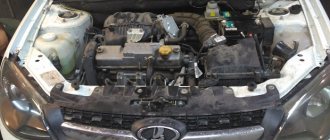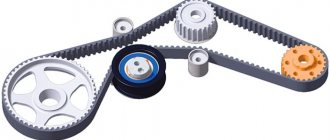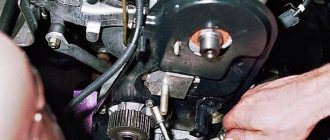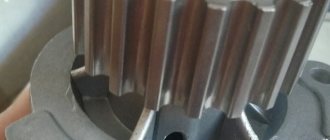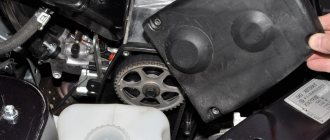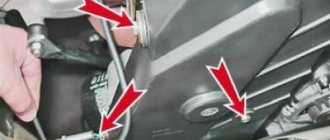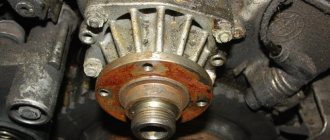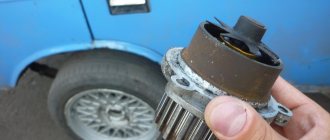Let's start with the fact that my typewriter is one year old. This year there have been few pleasant things and many not so pleasant ones. Ran 31 thousand kilometers. Main mileage: Kashira, Stupino, Moscow, several trips to Tula.
I have long been tormented by a strange knocking sound from the engine when cold. It didn’t cause any particular panic, as the engine warmed up and the knocking noise disappeared. And at 29,000 kilometers, the tapping stopped disappearing after warming up and even brought with it a crackling sound when starting off. Alternator, exhaust system, CV joint, front bumper and this is not a complete list of what I checked. There was still a pump and an automatic timing belt tensioner pulley, I opened the casing, but didn’t see anything suspicious. I went to a friend's service center to look at it with a more experienced eye. Based on the sound they said the pump, they opened the timing case and, sure enough, the timing belt was running along the pulleys. What I was most afraid of was this diagnosis because there are no spare parts for the Lada Grant at all. I surfed the forums and Drive2, found a couple of cases where a pump from a Priora was installed, it was said that the difference was only in the width of the pulley, and even then not by much.
Engine Cooling Water Pump
Here it is, a mine - a water pump. Refers to the cooling system, but is driven by a timing belt. If the pump wedges due to the death of the bearing, it will cut off the teeth on the belt, and then there will be destruction in the motor. And they “forgot” to mention this detail in the routine maintenance section of all service books.
New VAZ engines are now equipped with high-quality timing belts from well-known brands. I believe that if no oil gets on it, it will cost 180 thousand. But is the difference in components really so great that on the 8-valve VAZ-11186 for Granta the belt must be changed at the 75th thousand, and on its closest relative VAZ-11189 at the 180th?
Let's continue the research. The pulleys are not demolished at all. Pressure roller bearing up to 180 thousand? Let's admit it, although it's hard to believe. But why change all this equipment at the 180th thousand, if the estimated life of the engine is 220 thousand km? Refresh before demise or major overhaul? If you don’t believe me, look at the photo taken in the workshops where VAZ engines are produced.
Timing belt
How would you act on your own without clear instructions in the service book? On both an 8-valve and a 16-valve engine, I would change at least the pump, and better yet, the belt and tensioner between the 60th and 70th thousand kilometers. According to the period, if the mileage is small, for the sixth year of operation.
Many owners of domestic LADA models know that Granta, Kalina, Priora, Vesta and XRay are classified as “plug-in”, that is, when the timing belt breaks, the pistons meet the valves and then the engine faces expensive repairs.
To prevent this from happening, you need to change the pump, tension rollers and the belt itself in time.
What the manufacturer is silent about
The average car owner has information on servicing his VAZ model only from the factory instructions. For example, the booklet for the LADA Kalina indicates the service life of the belt, but there is no mention of its planned replacement. In the LADA Granta operating book, the manufacturer indicates the mileage of the timing belt for an 8-valve engine, while there is no information at all about the 16-valve version.
In some LADA Priora service books, the timing belt is not mentioned at all.
Vesta and XRay car owners are “lucky” - the service book indicates the timing for adjusting the timing belt gaps.
The planned replacement of the timing belt and rollers is indicated only in the instructions for the 8-valve engine of the Vesta and VAZ-11189 models, while it is recommended to replace the same belt twice, while there is not a word about the pump at all.
Water pump
Neglecting to replace and maintain the water pump can render the power unit inoperative. Let us remember that the pump belongs to the cooling system, but is driven by a timing belt. When the pump jams, due to bearing wear, the teeth in the belt are cut off and the motor is destroyed. All these details are familiar to the craftsmen, while the manufacturer did not even think to mention the need to monitor the condition of the water pump.
When to change the belt and pump
It should be noted that the new AvtoVAZ engines have high-quality timing belts, and if oil does not get on them, then they will run for the indicated 180 thousand kilometers.
Replacing parts on different types of engines
How to change a pump on a Grant with an 8-valve or a 16-valve, there is not much difference. The algorithm described above remains unchanged, taking into account one nuance: on the “eight” the crankshaft is equipped with one pulley, on the “sixteen-valve” - two. The replacement procedures will be identical, but when working with a 16-valve engine, the car enthusiast will need more time to complete the work.
It should be noted that when purchasing a pump, you need to pay attention to what type of engine the product is intended for. The packages are marked so that the car enthusiast can select the right part for an 8-valve and 16-valve engine, respectively.
Symptoms of pump failure
The resource of a modern water pump of a VAZ injection engine averages from 40,000 to 50,000 km. Pump failures caused by its operation are diagnosed quite simply. To determine the causes of the malfunction, you will need to visually inspect the CO section of the water pump, or completely dismantle this section. The most typical symptoms of a malfunction include:
- leaks in the area where the water pump is located;
- the coolant level in the tank drops sharply;
- the motor begins to heat up rapidly;
- At the location of the pump there is noise and humming of the bearings.
Korean-made coolant pump for VAZ-21179 engine
The owner of any elderly foreign car with a timing belt will confirm that repairmen insist that during a scheduled belt change, they replace both the pump and the pressure rollers with bearing assemblies. And these parts are often sold as a set. Moreover, at a discount - the whole set is cheaper than the belt, rollers, and pump separately.
I don’t want to once again convince you that the stingy pays twice, but over the years I have come to the conclusion that Western manufacturers include in the regulations changing the belt not because of the belt as such, but because of the pump and tensioner bearings. They just needed a reason to reliably replace the entire set of parts associated with the camshaft drive, and they found it.
I propose to do the same with our engines. Why? Formally, at each maintenance it would be necessary to remove the cover and inspect the timing belt and water pump. You can see a tear in the belt, as well as a leak on the pump. In both cases, the part is changed without delay. But this is a malfunction. And if everything is outwardly normal, the ideal option is to include preventive replacement in the regulations.
Malfunctions
Water pump for car
The causes of failure can be different, for example, bearing jamming or the formation of play. Sometimes it happens that the impeller begins to spin freely, but separately from the shaft. The pump also needs to be replaced if it leaks or becomes noisy.
Life time. A lot depends on the quality of the pump. For example, a low-quality and defective pump can last only 10-15 thousand km. The service life of a high-quality part is when the Priora runs 100 thousand km. and more.
The manufacturer installs a pump on the Priora, produced by the Russian enterprise Togliatti Automotive Units Plant (TZA). It has a long service life.
Unfortunately, recently sales of counterfeit pumps from TZA have become more frequent. Is it possible to distinguish a fake so that your Priora does not suffer?
A high-quality box should contain a pump, inside the box there should be a warranty card with stamps and the date of manufacture and a gasket. It is mandatory to have a holographic sticker on the pump.
Signs and causes of failure
You can identify a broken part by the following signs:
- insufficient circulation of coolant and, as a result, frequent overheating of the engine;
- presence of smudges at the pump mounting location.
hum of bearings at the pump mounting location;
These markers indicate the most likely causes of malfunctions in the Grants pump:
- bearing wear or damage;
- damage to the seal;
- worn sealing gasket;
- broken pump impeller.
In most cases, the part becomes unsuitable for major repairs and requires a complete replacement. Ignoring pump problems leads to replacing the timing belt and replacing components of the connecting rod and piston group. Valves and bearings may also need to be replaced.
Let's sum it up
Now you know which pump is best to choose. Try to timely diagnose and replace the coolant pump on your LADA Granta. Use only high-quality products, which will allow the components of the unit to serve for a long time and properly. Don’t be lazy to compare different products from among the offers, because this is a reasonable action in terms of selecting the optimal option.
The Lada Granta pump is an essential component of the car’s cooling system. The pump is responsible for the circulation of coolant and, as a result, for the functional state of the Granta cooling system. The water pump operates in the temperature range (-40ºС) - (+40ºС) with air humidity up to 90 percent. The water pump operates by rotating the timing belt. Every Lada Granta 8-valve with a 1.6-liter engine is equipped with a pump-type water pump.
Why do you need a pump in a car?
The power unit of any vehicle works in close connection with the cooling system. Constant circulation of antifreeze (or antifreeze) through the system ensures proper cooling of the engine and protects the rubbing parts of the engine from overheating. Accordingly, if there were no cooling system, the motor could not be considered a working unit - at the first load it heats up to a critical temperature and boils.
The operation of the cooling system fits into a simple scheme:
The driver pours antifreeze into the expansion tank.
After the engine starts, antifreeze begins to flow into the pump cavity.
From there, the fluid under pressure is directed to the radiator device and to the cylinder block.
Accordingly, the pump in this scheme plays the role of pumping equipment, which ensures the continuous supply of coolant to the engine.
The device is made of hard metal alloys, which allows you to extend the service life of all moving and rubbing parts of the pump
On the Lada Granta, the pump starts when the engine is ignited. The pump itself is part of the gas distribution mechanism: its impeller blades will rotate as long as the pulley rotates through the timing belt.
The structure and principle of operation of a water pump
How to set the clock on the device on the Lada Granta
The design and principle of operation of the water pump on almost all car models is almost the same, especially when comparing parts from domestic manufacturers. The same can be said about the location of the pump.
The water pump is installed next to the radiator and, when starting the engine, is driven by a hydraulic timing belt.
The pump structure consists of the following main parts: housing, shaft, impeller, drive pulley, bearing, oil seal and drive pulley hub. A shaft with an impeller at the end is installed in the cover. The shaft is driven by a timing belt. By rotating, the impeller moves fluid in the system, causing it to constantly circulate and thus cool the engine.
The drive pulley is installed at the other end of the shaft; in some pump versions, a fan is additionally installed. The timing belt is placed directly onto the drive pulley. The rotational energy of the engine is transmitted through the timing belt and drive pulley to the shaft, thereby causing the impeller to rotate and powering the entire system.
Very often, the pump begins to malfunction due to wear of the oil seal installed between the impeller and the housing. When the oil seal reaches the end of its life, coolant (antifreeze or antifreeze) begins to seep through it and gets onto the bearings, thereby washing away the lubricants.
Good craftsmen know that this is very bad for the bearing, almost fatal. Without lubrication, it begins to hum and soon fails. In this case, the result is the same: the bearings jam and the pump stops working. Water pump malfunction: causes and possible consequences
Signs of a pump malfunction on a Lada Granta car
"Lada Granta" continues the best traditions of the automotive industry of the domestic plant, and therefore its design does not cause any particular difficulties in diagnostics. To identify a pump malfunction, you do not need to look at the instruction manual or contact the services of a service station specialist. There are only three signs of a water pump failure that the driver can identify on his own.
The engine started to get very hot
If the Granta, even in winter, starts to get very hot while driving, and the fan can no longer cope with cooling the engine, then this is a clear sign that the pump has failed. The thing is that the presence of coolant in the system does not yet guarantee engine cooling, since if there is no pressure, then the liquid simply will not flow to the cylinder block.
You can confirm your suspicions in a fairly simple way:
Wait until the engine warms up to its operating temperature.
If only cold air begins to come out of it, then the circulation of antifreeze in the system is disrupted. Most likely, the problems are associated with severe wear of the pump impeller blades, and therefore you need to replace the pump with a new one as soon as possible.
Instrument readings in the cabin indicate that the engine is very hot - this is a reason to look under the hood and check the condition of the pump
Timing belt wears unevenly
Often drivers, having decided to change the timing belt, are surprised to notice that it is worn out on only one side. Of course, this is not normal for the operation of a rubber product - the timing belt design is designed for uniform planned wear of each part.
The timing belt rubs on one side due to the fact that the bearings on the pump shaft are loose . Accordingly, if there is asymmetrical wear on the timing belt, this indicates that the pump is about to fail. Usually, if the bearings become loose, the driver hears a loud crunching or banging sound from under the hood while driving.
Even after a short period of operation, the belt will begin to wear out on only one side if the pump bearings are worn out.
Pump leaking
Even a high-quality water pump cannot last forever. Therefore, over time, the pump seal (the most vulnerable component of the pump) will begin to wear out and, as a result, leak. And an antifreeze leak in the timing belt area clearly indicates that the pump has lost its tightness and is no longer performing its function to the required extent. Of course, if the leak is small, then the car can be used for now, since the system will still provide engine cooling. However, at any moment the oil seal can completely break through, and all the antifreeze will flow out of the crankcase.
In some cases, water pump leaks are observed not only due to the wear-out of the oil seal, but also due to improper installation of the rubber seal when replacing the pump.
Abundant release of antifreeze in the timing belt indicates depressurization of the water pump
Possible problems after replacement
Unfortunately, behind the apparent ease of removing and installing the pump, several problems can be hidden. For example, the pump is very sensitive to tightening - as soon as you twist the bolts a little, the gasket is squeezed out. Many such nuances may arise after replacement.
There was a noise
Noise and whistling sounds from the pump while driving are the most common problem after replacement. There may be several reasons for new sounds:
the bolts are tightened too tightly;
If noise does not affect the performance of the cooling system in any way, that is, fluid circulation is carried out normally, then the part does not need to be changed.
The stove began to heat poorly
If, after replacement, the stove in the cabin began to produce slightly warm air or stopped heating altogether, then there is an air lock in the cooling system. It is necessary to warm up the car to operating temperature and sharply accelerate it - as a rule, these measures are enough for the traffic jam to be overcome and the heater to work as usual.
Also, problems with “heating” can arise due to the fact that the impeller blades on the new part have a slightly different gap. It is impossible to solve this problem, so it is recommended that you initially select a pump from the same manufacturer as the old product, with identical markings.
It is recommended to give it a good throttle to break through the air lock.
Good night! a couple of days ago I changed the pump on the Hunter 409 engine, and the heater at idle began to blow slightly warm air, when you put it on the gas and keep it at rpm it starts blowing hot, the temperature floats from 80 to about 100 when the idle is about 100 at rpm it drops to 80. When the old pump was standing, it was hot in the cabin in the cold, but it rattled, the impeller on the old one was like a textolite round one in the middle with slots like a spiral, and on the new one the impeller was like blades. Due to the difference in the impellers, can the fluid be driven worse? and it seems like they write that since 2007, only impellers have been installed on pumps, or what about blades?
Chink
https://forum.uazbuka.ru/archive/index.php/t-124342.html
The motor gets very hot
Engine overheating can only be associated with poor performance of the cooling system. Consequently, if after replacement the engine begins to get very hot, the pump does not perform its functions or works “at half strength.” Immediate replacement is recommended.
Replacing the water pump on Grant (8 valves)
The driver can change the pump on an 8-valve Lada Granta without going to a service station. The main thing is to follow the replacement instructions and, upon completion of the replacement, set the crankshaft and pulley values correctly. Usually, along with the water pump, it is customary to change the timing belt.
Where is the pump located?
Since the pump is put into operation by a gas distribution mechanism, it is quite obvious that it will be built into the timing system. That is, you need to look for the location of the pump on the Lada Granta on the right side of the engine.
It is impossible to visually see the pump before removing the timing belt - only the pump pulley is visible, which is what starts the impeller into operation.
The water pump is included in the timing belt assembly
Preparing tools
To work, you will need several wrenches, standard auxiliary tools and materials:
wrench 10;
socket head 10;
wrench 17;
a screwdriver with a flat and thin blade;
container for draining coolant (at least 10 liters);
Replacing the pump on a Lada Grant does not require special tools - a standard set of tools is enough
How much coolant should be drained and refilled when replacing
Regardless of the availability of time or desire of the driver, you will still have to drain the antifreeze when changing the water pump. This is necessary in order to relieve the existing pressure in the cooling system and protect yourself from possible risks. However, the main question is how much liquid needs to be drained.
Traditionally, when replacing a pump, the entire volume of antifreeze is drained, since the new water pump will need new coolant. However, if new antifreeze was recently filled in, then there is no point in replacing it. It is enough to drain 4–5 liters of liquid to reduce the pressure, and then pour the same liters back.
Antifreeze is completely drained in 10–15 minutes
Draining can be done in two ways:
Disconnect the pipes from the radiator and place a container under the drain holes. This method allows you to remove almost all liquid from the cooling system.
Unscrew the plug from the expansion tank housing - no more than 5 liters of antifreeze will leak out.
New coolant should be added only after all installation work has been completed. It is recommended to make sure that the antifreeze supply and discharge hoses are tightly connected to the fittings.
Pump replacement procedure
On an 8-valve Lada Granta, changing the water pump is somewhat easier than on a 16-valve one. All actions of the owner fit into the following scheme:
How to check it yourself
There is an easy way to diagnose a water pump. There is no need to remove the product from the engine. To check the pump on the vast majority of car models, you must:
Start the engine, warm it up to normal operating temperature (usually this indicator varies from 87 to 100 degrees).
After this, pinch the upper pipe that comes from the radiator with a gloved hand. If the pump is working properly, you will immediately feel the antifreeze pressure inside the pipe. If the pipe is pressed without difficulty, there is no circulation in the cooling system, that is, the pump does not work.
You can check the functionality of the pump in a minute, especially if under the hood is clean and there are no liquid leaks
During the check, you need to be as careful as possible, since the coolant can become very hot, which affects the temperature of the pipe.
Characteristics of the differences in the procedure for Lada Granta 8 and 16 valves
In general, there are no significant differences in the design of engines with 8 and 16 valves in the Lada Granta. However, the procedure for replacing the water pump will differ in only one way: the 8-valve model has one crankshaft pulley, and the 16-valve model has two.
Accordingly, dismantling and installing the water pump on 16-valve versions will take more time, but the replacement scheme will be identical for 8-valve models.
On a Lada Granta car with a 16-valve engine, two crankshafts are installed, and therefore the time required to replace the pump increases significantly
When choosing a new pump, you need to be careful: water pumps of various designs are installed on Lada Granta with 8 and 16 valves. That is, they cannot be considered interchangeable, as is usually the case with other modifications of VAZ cars.
Identifying a faulty pump on a Lada Grant and replacing it yourself is a completely accessible procedure for any driver. The work does not require special equipment - a standard set of tools that can be found in any garage will be used.
Purpose and recommendations
Lada Granta liftback: do-it-yourself tuning
The pump serves to ensure correct and sufficient circulation of fluid in the engine cooling circuit of the Lada Granta, which has 8 valves. The element requires periodic attention, which will allow the system to operate for a long time without sudden and unpleasant surprises. Neglecting the control action may lead to a sudden breakdown, and this will inevitably lead to overheating of the motor.
A high-quality product has a positive effect on the performance of the heating system of the Lada Granta version of 8 valves. The presence of counterfeits is very common, so you should be on the safe side in advance and discuss with the seller the details of returning substandard goods.
Which pump to choose? For the Lada Granta model, we recommend choosing an 8-valve pump between two manufacturers that have earned trust among car owners, namely:
- "TZA" (Tolyatti Plant of Units);
- "LUZAR" (Lugansk Automobile Radiator Plant).
An important aspect of the choice is to focus on the color scheme present on the cases of the original products. It would also be useful to compare the grooves and stiffeners made on the impeller. We recommend that you carefully check the entire list of markings and inscriptions with those on the original products.
Today, the market space is able to offer an impressive range of these products for the Lada Granta, which has 8 valves. A guaranteed option to avoid a collision with a fake is to take the original pump with you. Lack of experience in “communication” with spare parts of this kind can play a cruel joke on the buyer.
Which pump should you choose? You can purchase a pump from an official dealer, and if this option is not available, below we provide guidelines for the following analogues with a price parameter:
There is an opinion that you can find an “original” on the market at a dubious price, from 500 rubles. However, it is not possible to guarantee the authenticity of the product, so here only the buyer is responsible for weighing this step.
How long does it take to change the pump on a grant?
To avoid being blown up by a mine, it is enough to know where it is laid. Let's play sapper and find out when you really need to change coolant pumps and timing belts on VAZ engines.
Domestic engines for Grant, Kalin, Prior, Vest and Iksreev, with the exception of VAZ-11183, belong to the “plug-in” category. What this means is that when the timing belt breaks, the pistons meet the valves. Read - it exploded and led the engine to destruction, which was expensive to repair.
With Vesta and Xray, progress is obvious - at 45, 75, 105, 135 and 165 thousand we adjust the gaps in the gas distribution mechanism. And for the first time we plan to remember the timing belt along with the rollers for 180 thousand kilometers! This is for 16-valve engines VAZ-21129, 21179 and 8-valve Vesta VAZ-11189. I can’t do without the quote: “2.11. Replace the timing belt along with the rollers. 2.12. Replace the crankshaft and camshaft sprockets. Replace the toothed belt, tensioner and support roller (for the VAZ-11189 8-cl. engine, only the tensioner) of the engine gas distribution mechanism drive. Adjust the tension of the toothed belt." Not only is the oil oil (we change the same belt twice), but of all the parts, they didn’t remember the most vulnerable one - the pump!
New VAZ engines are now equipped with high-quality timing belts from well-known brands. I believe that if no oil gets on it, it will cost 180 thousand. But is the difference in components really so great that on the 8-valve VAZ-11186 for Granta the belt must be changed at the 75th thousand, and on its closest relative VAZ-11189 at the 180th?
Let's continue the research. The pulleys are not demolished at all. Pressure roller bearing up to 180 thousand? Let's admit it, although it's hard to believe. But why change all this equipment at the 180th thousand, if the estimated life of the engine is 220 thousand km? Refresh before demise or major overhaul? If you don’t believe me, look at the photo taken in the workshops where VAZ engines are produced.
I don’t want to once again convince you that the stingy pays twice, but over the years I have come to the conclusion that Western manufacturers include in the regulations changing the belt not because of the belt as such, but because of the pump and tensioner bearings. They just needed a reason to reliably replace the entire set of parts associated with the camshaft drive, and they found it.
I propose to do the same with our engines. Why? Formally, at each maintenance it would be necessary to remove the cover and inspect the timing belt and water pump. You can see a tear in the belt, as well as a leak on the pump. In both cases, the part is changed without delay. But this is a malfunction. And if everything is outwardly normal, the ideal option is to include preventive replacement in the regulations.
Replacing the pump (water pump) on a Lada Granta is done in two ways: if the pump “hangs” on the timing belt, then by replacing the timing belt, if separately from the belt, then without removing the timing belt. Replacing the pump on a Lada Granta can only be entrusted to a motor mechanic at a car service center. It is strictly not recommended to change it yourself.
Along with replacing the pump on a Lada Granta, it is necessary to change the gasket of the pump (water pump). When purchasing a pump, pay attention to whether the pump gasket is included. In cheap pumps, the gasket is sold separately. When replacing the pump on a Lada Granta, it is better to immediately replace the antifreeze. You should not decide to replace the pump yourself. Do a diagnostic of the cooling system, the mechanic will be able to accurately determine whether it is the pump or not and will guarantee that replacing the pump will correct the problem.
Cost of replacing a water pump (water pump) on a Lada Granta:
| Replacement options | Replacement | Pump price |
| Replacing the Lada Granta pump, without timing belt | from 2,000 rub. | from 1,100 rub. |
| Replacing the Lada Granta pump, with timing belt removed | from 4,500 rub. | from 1,100 rub. |
In terms of time, replacing the pump on a Lada Granta takes from 2 to 12 hours, depending on the engine size.
Pump replacement warranty
- 180 days.
Rating of Lada Granta pump manufacturers based on owner reviews: 1. Graf (Italy) 2. Airtex (Spain) 3. SKF (Sweden) 4. Luk (Germany) 5. Ruville (Germany)
When you need to change the pump on Lada Granta:
— backlash of the pump drive pulley; — extraneous sounds from the pump; - leaks on the pump; — the antifreeze leaves, but no leaks are visible.
Engine Lada Granta
The main defects of the Lada Granta water pump are coolant leaks and bearing wear (determined by increased noise and hum during operation). Repairing a water pump, as a rule, does not lead to the desired result, so it is recommended to replace the pump assembly.
You will need: keys “10”, “17”, two screwdrivers.
Which kit to buy
In addition to the toothed belt, a tension roller and a coolant pump are purchased.
The main supplier of rubber products is the RTI plant in Balakovo. Products from GATES, BOSCH, DAYCO, CONTITECH have proven themselves well. If the pump in the engine cooling system is replaced, antifreeze will be needed to top it up. Yesterday one of our regular customers came to us with a recently purchased second-generation Kalina to replace the timing belt, roller and pump, plus all the fluids, but more on that in another article. This engine was also installed on the Grant, so this article will be relevant for it as well. The speedometer shows 60,000 and I believe that for this engine this is the optimal replacement interval, even though all reference books say about 75,000.
To work, we will need a set of keys and sockets, as well as a 5-point hex and a key for the tension roller. The entire procedure takes approximately one and a half hours.
The engine is similar to the eighth.
First, remove the protection, drain the antifreeze, and for convenience you can remove the right front wheel. Next, loosen the locknut of the generator belt tensioning mechanism. Using a 10mm socket, unscrew the tensioner pin and remove the belt.
We unscrew the four bolts with a 5mm hexagon and remove the upper protective cover of the timing belt.
Set top dead center (TDC). We turn the crankshaft by the pulley mounting bolt clockwise until the mark on the camshaft sprocket and the timing belt protective casing coincide.
Unscrew the crankshaft pulley bolt. We block the wheels with stops, tighten the handbrake, engage fifth gear and, with a slight movement of the wrench and a one and a half meter pipe extension, unscrew this bolt.
Remove the protective washer.
The marks on the crankshaft sprockets should be aligned with the oil pump casting.
Praise be to the designers of AvtoVAZ, finally rollers with a tension indicator appeared on the engines, now you don’t need to tighten them by eye and check the tension by twisting the belt, not even thirty years have passed since the invention of such a design. We unscrew the tension roller bolt and dismantle the latter; we also remove the old timing belt. The photo shows that the belt has stretched out because the tension marks have diverged; when checking the condition of the timing belt, if you see this, you will just need to tighten it.
To replace the pump, we need to remove the camshaft sprocket, and also unscrew several bolts of the inner casing and remove it.
Three bolts out and the pump replaced. The green arrow indicates the hole for the tension roller bolt.
Having replaced the water pump, we proceed to install a new timing belt.
We put the casing and camshaft sprocket in place. We check that all the marks match, as discussed above. We install the tension roller, but do not tighten the bolt. We put on a new belt, observing the direction of rotation, first on the crankshaft sprocket, camshaft, tension roller and pump, the latter can be swapped. We tighten the timing belt. Use a special key to turn the roller counterclockwise, as indicated on its body...
...until the marks on it coincide and tighten the bolt.
We turn the crankshaft two turns and again check the alignment of the marks and the belt tension.
We install all the parts in the reverse order of removal, fill in antifreeze and start it. It couldn't be simpler. Good luck on the roads. No nail, no rod!
Replacing the timing belt of Lada Granta 8 valves is required once every 75 thousand kilometers. If you ignore the scheduled replacement of the belt, tension roller and sometimes the pump (coolant pump), you may end up with serious repairs to the Lada Granta engine. After all, a broken timing belt almost always leads to damage to valves, valve seats and even pistons. Therefore, the timing drive must be treated very carefully. Every 15 thousand it is necessary to inspect the belt for breaks, cracks, peeling or oiling.
The advice applies to VAZ, 11186 and 21116 engines. All of them are 8-valve and are installed in Grant cars. Let's consider replacement steps.
First, remember a simple rule: the 11183 engine cannot bend its valves, so you can rotate the crankshaft and camshaft pulley separately. For motors 11186 and 21116 this would be unacceptable!
Operations to replace the water pump (pump) Lada Granta
1. Disconnect the wire from the negative terminal of the battery.
3. On VAZ-21116 and VAZ-111 engines, remove the four bolts securing the upper part of the front cover of the timing gear drive.
5. On the VAZ-11183 engine, remove the three bolts securing the front cover of the gas distribution mechanism drive.
7. On the VAZ-21126 engine, using a 5-point hex key, remove the five bolts securing the upper front cover of the timing belt
9. Set the piston of the 1st cylinder to the TDC position (see “Installing the piston of the 1st cylinder to the TDC position of the compression stroke on a Lada Granta car”).
10. Remove the tension roller (see “Replacing the timing belt and tension roller”).
After removing the timing belt, it is prohibited to turn the camshaft and crankshaft.
11. Remove the camshaft timing pulleys (see “Replacing the cylinder head gasket”).
12. On VAZ-21116 and VAZ-11186 engines, remove the crankshaft pulley mounting bolt.
Service life of the timing belt and generator, pump, as well as Kalina tension rollers
How long do factory timing belts, alternator belts, as well as tension rollers for both timing belt and alternator last? Mine are personal.
Description and technical characteristics of water pumps DOLZ, LUZAR
The DOLZ pump is installed on Lada Granta cars with a modification of the VAZ 21116 engine. These are 8-valve units with a volume of 1.6 liters, a power of 87 horsepower, “Norma”, “Lux” equipment.
The manufacturer of the pump is Doltz, a Spanish concern that is famous for its high reliability and long service life of spare parts.
| Specifications | Equipment | |
| Paronite gasket | included 0.9 mm | 1.1 mm |
| Manufacturer | DOLZ | LUZAR |
| Belt pulley | In stock | In stock |
| Price | 1200 | 850 |
| Number of teeth | 21 | 21 |
| Warranty card | In stock | In stock |
| Type of packaging | Polyethylene | Polyethylene |
| Marking | Original number on the pulley, housing | Original number on the case |
| Impeller | Aluminum, six-blade, plastic coated, two mounting holes | Aluminum, seven-blade, three mounting holes |
| Impeller diameter | 63.2 | 64 |
| Pulley width | 24 | 27 |
| Distance to seat | 50 | 54 |
| Roller bearing outer diameter | 28 | 30 |
| Bearing width | 37 | 38 |
| Bearing type | Double row, ball | Ball roller |
| Roller diameter | 4.4 | 4.8 |
| Length of one roller | 8.4 | 12.0 |
| Ball diameter | 6.4 | 6.3 |
| Seal type | ceramics | ceramics |
Reinforced pump Luzar for Lada Granta 2190
Luzar Turbo 2 is a high-power water pump for the Lada Granta. The average cost in the Russian Federation is 650 – 750 rubles, depending on the place of purchase. Pump flow rate at 800 rpm is 900 l/h. The unit runs 95 – 120 thousand km.
The installation of a turbo version of the pump is explained by the fact that the engines of the Lada line are prone to rapid boiling and an increase in operating temperature.
The temperature increases according to the following scheme: the car moves at high speeds on the road. A sudden stop at a traffic light provokes a rise in temperature, heat stroke, and boiling of antifreeze.
| Characteristic | Indicators |
| Material | Poly Phenylene Sulfide |
| Strength | up to 210 M Pa |
| Elasticity | up to 21,000 M Pa |
| Impact resistance | up to 51 kJ/m2 |
| Stability under load | Yes |
| Performance | -60 to +220℃ |
| Resistance to hydrolysis | 0,03% |
| Low shrinkage | Yes |
Preparatory stage
The Lada Granta car can be equipped with two types of power units - 8 valves and 16. The difference in the timing mechanisms of these engines is that the 16-valve version has 2 camshafts, respectively, 2 gears instead of one in the 8-valve version. In addition, in addition to the tensioner, the mechanism contains an additional deflection roller.
They should also be replaced together with the timing belt, because worn rollers can cause the belt to break or jump on the gears. Then the valve timing is disrupted, the engine begins to “shake”, and the power drops noticeably. The replacement operation is quite accessible to any car enthusiast who has such a desire and some tools:
- a set of the most popular open-end wrenches and sockets;
- mounting blade (mount);
- flat screwdriver;
- jack;
- round nose pliers with curved pointed ends or a special fork for the tension roller;
- cloth gloves.
1 — toothed pulley of the engine crankshaft; 2 — tide on the oil pump cover; 3 — toothed pulley of the coolant pump; 4 - tension roller; 5 — toothed pulley of the exhaust camshaft; 6 — rear timing belt cover; 7 — toothed pulley of the intake camshaft; 8 — guide roller; 9 — toothed belt; A - TDC mark on the crankshaft toothed pulley; B — mark on the oil pump cover; C, F - mark on the rear timing belt cover; D — mark on the gear pulley of the exhaust camshaft; E - mark on the intake camshaft toothed pulley
Is there any point in renovation?
Of course, almost any spare part can be repaired, but the question is the feasibility of this idea. We do not recommend repairing the pump, since its cost is not exorbitant. In addition, it is extremely undesirable to restore the pump on cars in which the pump is connected to the timing belt. Otherwise, you risk a very serious risk, since a jammed pump can lead to a broken belt. And this is already fraught with dire consequences for the engine, requiring significant investments.

